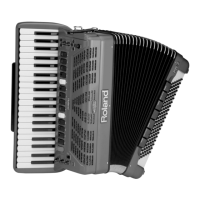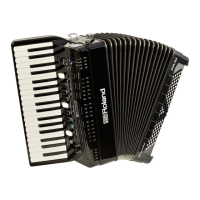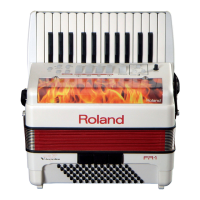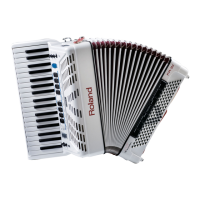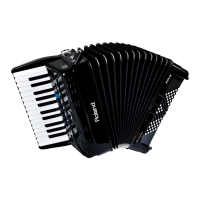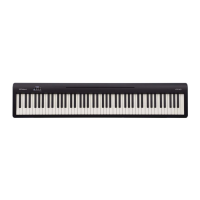Selecting Parameters
93
10.5 MFX Controls (Not for VTW Organ Tone)
Select this page to assign a control to the MFX.
Parameter Value Explanation
Control 1 Source O, EFX Pot, Aftert
Select “EFX Pot” to control
the MFX by “EFFECT”
potentiometer.
Select “After” to control the
MFX by aftertouch.
NOTE
The treble keyboard
of the piano-type
model also generates
aftertouch messages
(on the button- type
model, aftertouch can
be generated with the
Master bar). “Aftertouch”
refers to the fact that
you press a key even
further down after
playing a note.
Control 1 Sens -63~0~+63 Adjust the sensitivity.
Control 1 Assign
The eects to assign depend on the MFX type that
you selected. See “2.3 Eects Send” (p. 72).
Control 2 Source As “Control 1 Source”
Control 2 Sens As “Control 1 Sens”
Control 2 Assign As “Control 1 Assign”
Control 3 Source As “Control 1 Source”
Control 3 Sens As “Control 1 Sens”
Control 3 Assign As “Control 1 Assign”
Control 4 Source As “Control 1 Source”
Control 4 Sens As “Control 1 Sens”
Control 4 Assign As “Control 1 Assign”
10.6 Sound Edit (Not for VTW Organ Tone)
The following parameters allow you to set the
sound’s “envelope” and lters.
The envelope parameters aect both the volume
(TVA) and the lter (TVF). The cuto frequency
will rise as the envelope rises and will fall as the
envelope falls.
Parameter Value Explanation
ATTACK –64~0~+63
See “5.5 Sound Edit” (p. 80) for detailed
information.
DECAY –64~0~+63
See “5.5 Sound Edit” (p. 80) for detailed
information.
RELEASE –64~0~+63
See “5.5 Sound Edit” (p. 80) for detailed
information.
CUTOFF –64~0~+63
See “5.5 Sound Edit” (p. 80) for detailed
information.
DELAY –64~0~+63
This parameter adjusts the time required for
the vibrato eect to begin. Positive (+) settings
increase the time before vibrato will begin and
negative settings shorten the time
DEPTH –64~0~+63
See “5.5 Sound Edit” (p. 80) for detailed
information.
RATE –64~0~+63
See “5.5 Sound Edit” (p. 80) for detailed
information.
RESO –64~0~+63
See “5.5 Sound Edit” (p. 80) for detailed
information.
10.7 Controllers
These parameters further add to the realism of the
sounds emulated by your FR-8x.
Parameter Value Explanation
EXP PEDAL O, On
• Select “O” If you want to use
the bellows for expressive
purposes.
• Select “On” if you want
control the expression by foot
purchasing an optional MIDI
foot controller (e.g. FC-300).
ORCH CHORD
TOUCH
Fixed Low, Fixed
Med., Fixed High,
Low, Medium, High,
Fixed Low+Bellows,
Fixed Med.+Bellows,
Fixed High+Bellows,
Bellows,
This parameter allows you to
specify the velocity sensitivity
of the Right Hand section keys
when they are used to play
Orchestral 1 sounds.
• There are three “Fixed” curves
that always use the same value,
no matter how hard or lightly
you press the keys (no dynamic
control). “Low” means that a low
value is used, “Med” represents
a medium value and “High” a
high value.
• “Low”: means that even
relatively light key presses
already allow you to play loud
notes.
• “Medium”: is in the middle of
Low and High.
• “High”: represents the most
responsive velocity curve that
requires a considerable amount
of strength for fortissimo notes,
but it also provides more
expressive options.
• “Heavy”: provides a greater
variety of nuances.
• “Fixed Low+Bellows“, “ Fixed
Med.+Bellows”, “ Fixed
High+Bellows”: mean that
the selected orchestral sound
uses xed velocity values but
can also be controlled by the
bellows movements.
• “Bellows”: means that the
selected orchestral sound
is controlled by the bellows
movements not the velocity
values generated by the keys.
NOTE
This parameter allows you to
specify the velocity sensitivity of
the bass and chord buttons when
they are used to play one of the
orchestral sounds. It has no eect
on the VTW Organ sounds.
10.8 MIDI TX
This page contains a series of MIDI parameters for
the Orchestra Chord section you need to set one
by one.
These parameters are saved along with all other
Set parameters, which allows you to use dierent
MIDI settings for each Set and even each register
within a Set.

